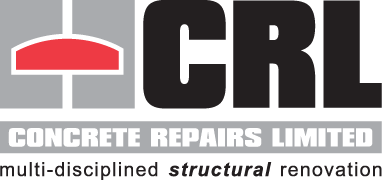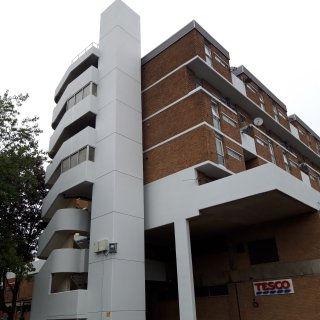Enhancing durability & prolonging the life of a structure
The primary deterioration mechanism for reinforced concrete is corrosion of the steel reinforcement. This is usually initiated by carbonation of the concrete at the depth of the reinforcement, or high levels of chloride ions at the steel concrete interface. Unless the chlorides were cast in the concrete as either an accelerator, or unwashed sea aggregates, this process of migration, and movement of the carbonation front takes place over a period of time, depending on the durability of the concrete cover. If we can slow down the rate of movement of either of these mechanisms, coupled with a reduction in the ingress of water and oxygen, we will delay the onset of corrosion of the reinforcing, and prevent any subsequent spalling taking place.
The first step in this process is to carry out a thorough concrete condition survey which will identify the depth of carbonation and chloride ion concentration in relation to the concrete cover to the steel. Once this has been established a decision can be made as to whether some form of corrosion prevention is necessary which will reduce the probability of concrete spalling in the future. The ideal, and easiest way to do this is by concrete coating: applying a coating (generally termed an ‘anti-carbonation’ coating) to the concrete surface. Anti-carbonation coatings reduce the ingress of carbon dioxide, oxygen and water into the concrete.
CRL are well experienced and competent in the cleaning and preparation of concrete, and the application of a variety of coatings systems. These include;
-
- anti-carbonation coatings,
- penetrating hydrophobic coatings (such as siloxanes and silanes),
- migrating corrosion inhibitors,
- decorative coatings, and
- cementitious coatings.
It is essential that these materials are applied in strictly in accordance with the manufacturer’s instructions. Our operatives regularly attend training courses with the various material suppliers to ensure they are familiar with the material and are aware of conditions under which it is to be applied. Surface preparation is very important to ensure a successful application of the coating, and CRL have a variety of surface preparation techniques available to remove existing coatings and prepare the exposed concrete.
Optimal environmental conditions are often needed with the application of specialist coatings. It is sometimes necessary to delay coating applications until the weather conditions are suitable, or contain and manage the work area using heaters and dehumidifiers. For quality control purposes throughout all coating applications set quality plans are in place to monitor the ambient air temperature, dew point, surface temperature, and humidity to ensure it is within the recommended parameters specified by the manufacturer.
Related Projects

"Coatings are a cost effective method for enhancing concrete durability. A properly applied 'anti-carbonation' coating is the equivalent to adding an extra 60mm of cover to the reinforcing."









